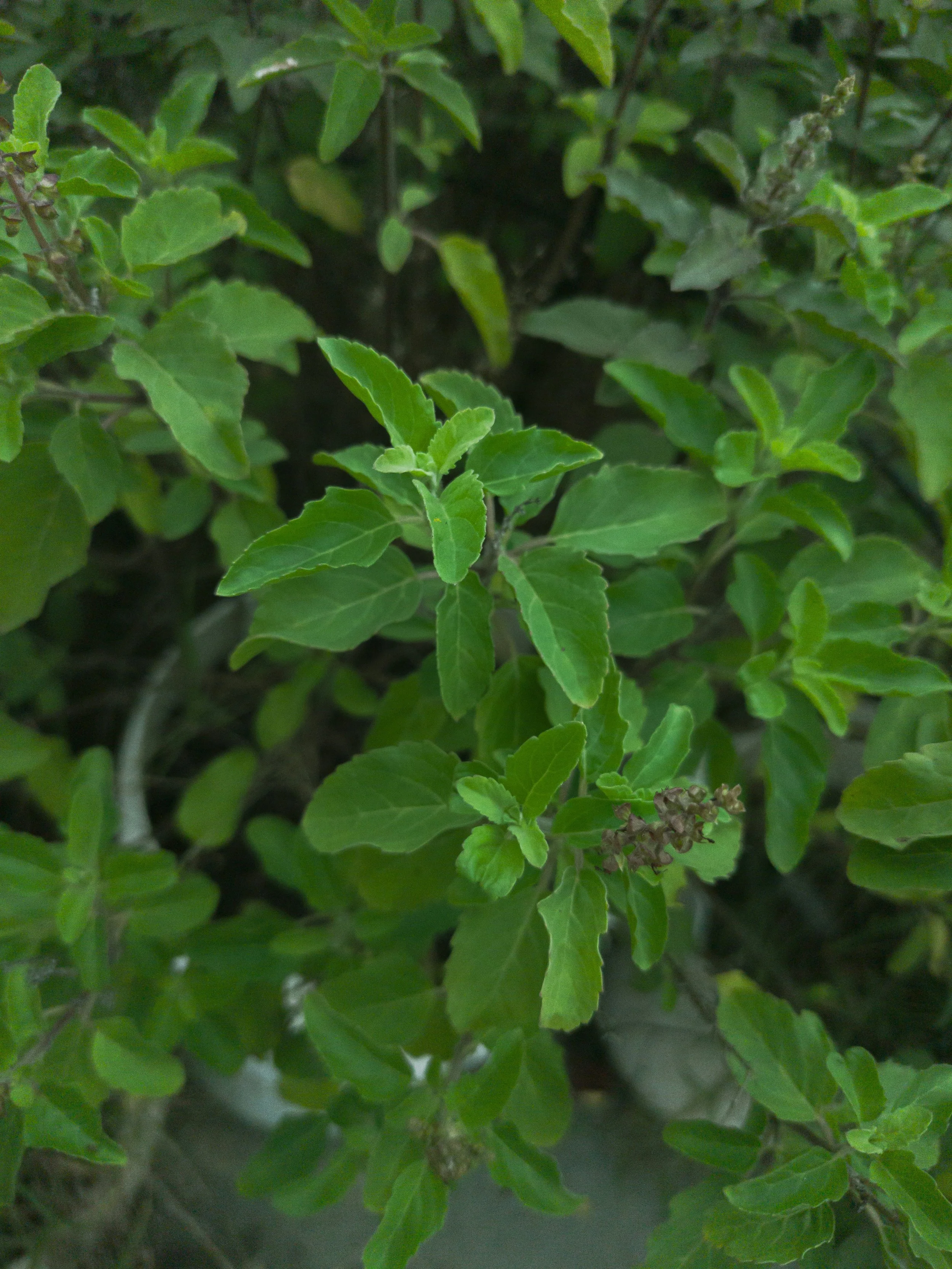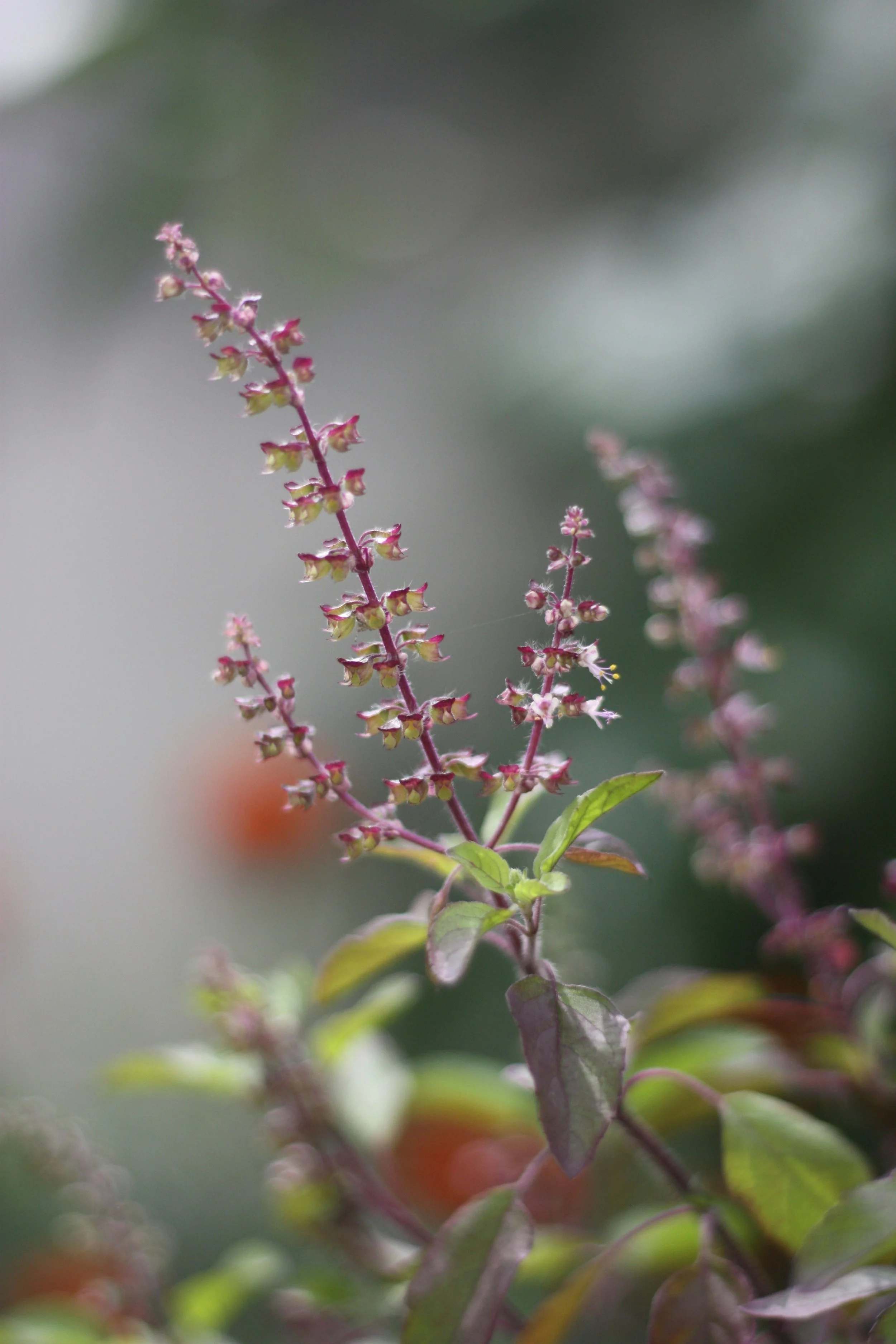Tulsi (Ocimum tenuiflorum)
“The incomparable one.”
Plant Profile
Tulsi is no ordinary basil. She’s a slender, shrubby perennial with slightly serrated green or purplish leaves and an aroma that feels both grounding and uplifting — clove, pepper, and a whisper of menthol. Her presence is unmistakable: she radiates a quiet strength, a sacredness that lingers long after you’ve brushed past her leaves.
In India, Tulsi is more than a plant; she is a living goddess. Grown in courtyards and temple gardens, she is tended daily with water, prayers, and offerings. Yet she is hardy — she thrives in tropical heat, often self-seeding and returning year after year, a steady anchor in the chaos of seasons.
Tulsi doesn’t ask for attention; she offers it. Her energy is that of a watchful guardian — protective, purifying, and gently insistent that you slow down and breathe.
Origin Story
Tulsi’s story is inseparable from India’s spiritual and medicinal traditions. Known as the “Queen of Herbs” and The Incomparable One, she is said to be an earthly manifestation of the goddess Lakshmi, bringing health, harmony, and protection to those who honour her.
Every part of Tulsi’s presence carries meaning. Her shrines stand in courtyards, where she is tended daily with water, incense, and mantras. In Hindu households, she is not merely grown but worshipped, her leaves offered in prayers and her presence thought to purify mind, body, and home.
In Ayurveda, Tulsi is classified as a rasayana — a rejuvenator. She is believed to balance all three doshas (Vata, Pitta, Kapha), supporting resilience against stress, aiding digestion, and strengthening immunity. Her adaptogenic qualities make her as relevant today as in ancient texts.
There is also a fierce side to her mythology: Tulsi is said to have emerged from sorrow and transformation, her roots reaching into stories of devotion, loss, and renewal. Perhaps that is why she feels so alive — a plant with a past and a purpose.
Soul Notes
Tulsi feels like a quiet guardian. She doesn’t rush you or shout for your attention; she simply holds space. There’s a steadiness in her presence, a whisper that says: “breathe… you’re safe here.”
Her scent is unlike sweet basil’s summer exuberance — Tulsi carries warmth and spice, with an undertone of earth that makes you want to linger. She smells like temples at dawn, incense rising in cool air, and the reassuring weight of rituals repeated over centuries.
She embodies resilience. Tulsi weathers heat, rain, neglect, and still stands with her arms open. She is the herb of balance — not the jolt of energy or the hush of sedation, but the gentle recalibration you didn’t know you needed.
When you reach for Tulsi, you’re not asking for a quick fix. You’re entering a relationship with a plant that tends to the unseen layers: body, mind, spirit, and the spaces in between.
Stillroom Notes
Uses: Supports immunity, balances stress, lifts low energy, and gently clears respiratory pathways. Known as an adaptogen, Tulsi helps the body find its way back to centre.
In tea: Tulsi tea is a warm embrace for frazzled nerves and tired lungs. Slightly spicy, a little sweet, and beautifully grounding — perfect for daily rituals or moments of overwhelm.
Essential oil: Deeply purifying and clarifying. A few drops in a diffuser can freshen a space energetically as well as physically, making her ideal for meditation corners or sickrooms.
Fresh/Dried: Fresh leaves hold the most potency for tea and ritual offerings. Dried Tulsi can be used in incense blends, bath soaks, or as a protective sachet in sacred spaces.
Ink Blot
I came to her thinking it was just going to be another basil. But the more I read, the more I wondered why this was even still a basil. The differences are quite big between the two plants really — a bit like the ginger cousin in a family of dark-haired people. Makes you wonder where the gene came from.
So I kept on reading. And reading. Ayurveda, adaptogens, the ancient idea that plants don’t just treat symptoms, they teach balance.
There’s a quiet reverence in every story I find about her. The daily rituals in Indian households — watering her, circling her with incense, whispering mantras. She’s not just grown; she’s honoured. Even her name, The Incomparable One, carries weight.
And then there are the big words: eugenol, caryophyllene, polyphenols. Are they science, or pseudo-science dressed up in wellness marketing? I’m not sure yet. But instead of putting me off, they make me want to dig deeper — to understand why Tulsi sits at the top of the basil royalty scale, revered not just in ancient courtyards but in modern studies too.
I think of how often I’ve reached for quick fixes — coffee for energy, wine for unwinding — and how different it feels to consider a daily Tulsi tea instead. A warm cup that doesn’t force, doesn’t sedate, but simply steadies.
And yet, she’s not perfect or easy. Her taste is stronger than sweet basil, her energy unfamiliar to my Western palate and pace. But maybe that’s the point. Tulsi isn’t here to please; she’s here to remind me of something I’ve almost forgotten — that tending to health is a sacred act, not an afterthought.
-
Tulsi’s healing legacy stretches back over 3,000 years in Ayurveda, where she is classified as a rasayana — a rejuvenator for body, mind, and spirit. She’s said to support the immune system, regulate blood sugar, ease respiratory congestion, and balance the nervous system. In Ayurvedic philosophy, she works across all three doshas (Vata, Pitta, Kapha), gently restoring harmony where there is imbalance.
Modern science has started catching up to her wisdom. Studies highlight her adaptogenic qualities — helping the body adapt to stress and modulate cortisol levels. Her high content of eugenol gives her antimicrobial and anti-inflammatory effects, while caryophyllene interacts with the endocannabinoid system to calm anxiety. Rich in polyphenols, she’s also a natural antioxidant, protecting cells from oxidative stress.
In clinical settings, Tulsi extracts are being explored for their role in managing stress-related disorders, respiratory issues, and even metabolic health. But for many, her power lies in simplicity: a daily cup of Tulsi tea to steady the nerves and lift the fog of a weary mind.
-
Ideal growing conditions:
Tulsi thrives in warmth and sunlight, preferring tropical or subtropical climates. She loves rich, loamy soil with good drainage and plenty of humidity to keep her leaves supple. In cooler regions, she can grow as an annual or a pampered indoor perennial with enough light.Best time to plant:
Sow seeds indoors in late spring or early summer when the risk of frost has passed. Transplant seedlings carefully — Tulsi doesn’t enjoy having her roots disturbed.Watering needs:
Keep her soil evenly moist but never waterlogged. Tulsi responds well to regular attention — think of it less as a chore and more as part of her ritual care.Pruning:
Pinch off flower buds as they appear to encourage bushier growth and extend her leaf production. Regular harvesting not only keeps her productive but also deepens her fragrance.Harvest tips:
The best time to harvest is in the morning, when her volatile oils are at their peak. Take small cuttings from the top, allowing lower leaves to continue gathering energy. Fresh leaves are ideal for tea, tinctures, and sacred offerings.Varieties of Tulsi:
Rama Tulsi – green leaves, mild flavour, and calming energy.
Krishna Tulsi – darker purple stems and leaves, with a stronger, spicier taste.
Vana Tulsi – wild variety with larger leaves and a lighter, lemony aroma.
-
Planetary correspondence: Jupiter (expansion, wisdom, spiritual growth)
Elemental association: Fire & Air (transformation and breath)
Polarity: Feminine
Chakra alignment: Heart & CrownMagical uses:
Purifies spaces and auras; burn dried Tulsi leaves as incense to clear stagnant or heavy energy.
Invites protection and harmony into the home; plant near doorways or windows to guard against negativity.
Supports spiritual devotion and meditation; keep a fresh sprig on your altar or in your sacred space.
Ritual uses:
Steep Tulsi leaves in a cleansing bath to release emotional weight.
Offer fresh Tulsi with prayers for healing or forgiveness.
Brew tea and sip mindfully before journaling or spiritual practice to encourage clarity and insight.
Mythical resonance:
Tulsi is said to have been born from tears — the tears of a goddess who transformed her grief into devotion. In her, sorrow and strength coexist. She is a plant of thresholds: between health and illness, chaos and calm, earthly and divine.
When to Reach for Tulsi
For Stress & Overwhelm
A daily Tulsi tea helps steady the nervous system and support your body through the ebb and flow of life. Sip slowly and let her grounding warmth take hold.
For Respiratory Support
Add fresh Tulsi leaves to steam inhalations to help open airways and ease congestion — a simple act of care for tired lungs.
For Cleansing Spaces & Energy
Burn dried Tulsi leaves as incense to purify your home after arguments, illness, or heavy days. Her smoke clears not just the air but the mood too.
For Sacred Rituals
Place a sprig on your altar or in your journal as you set intentions. Tulsi’s energy supports devotion, forgiveness, and quiet strength.









